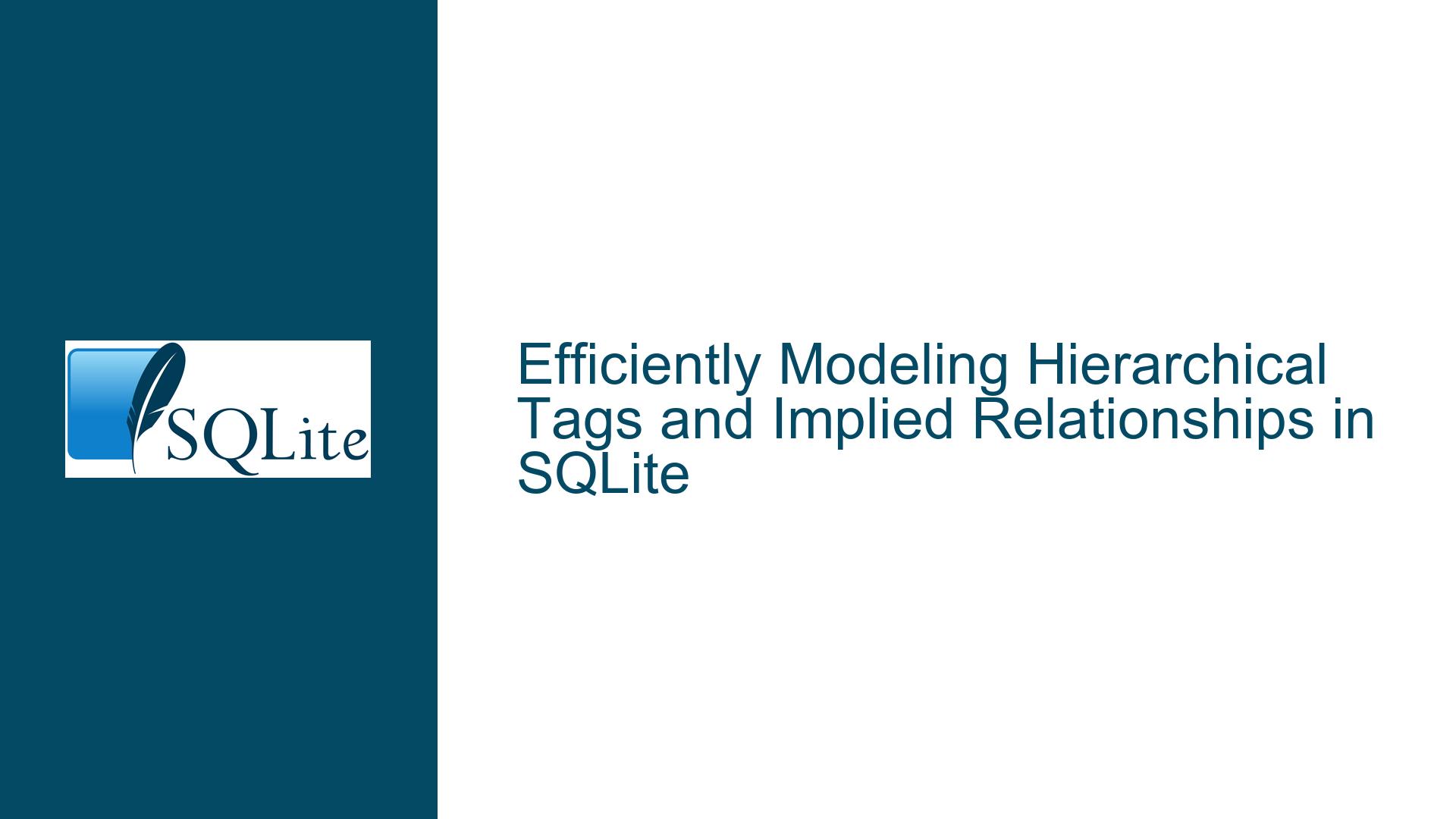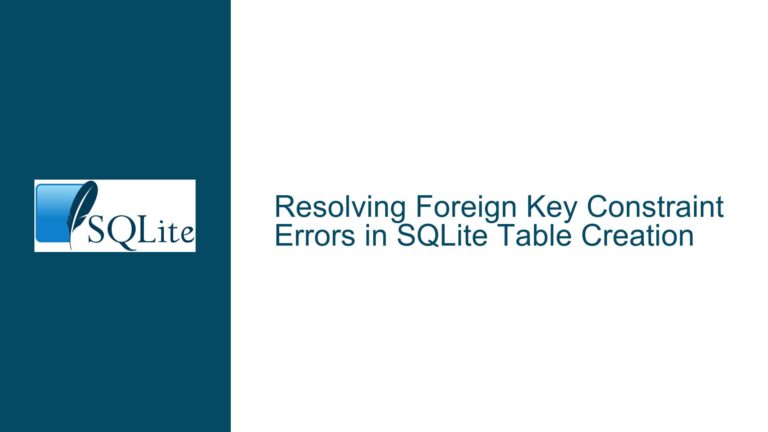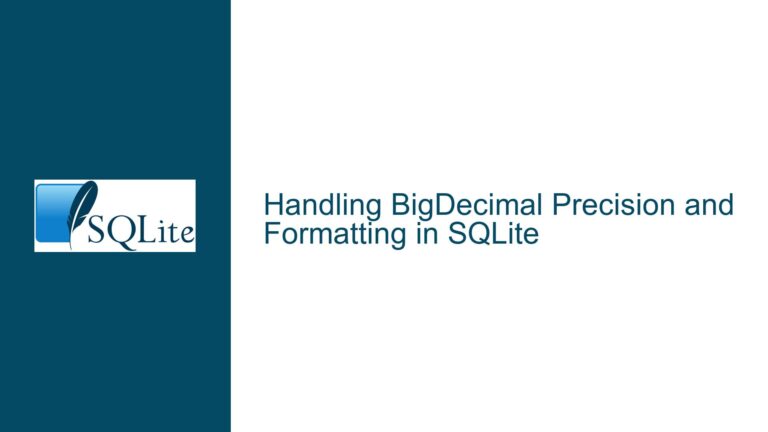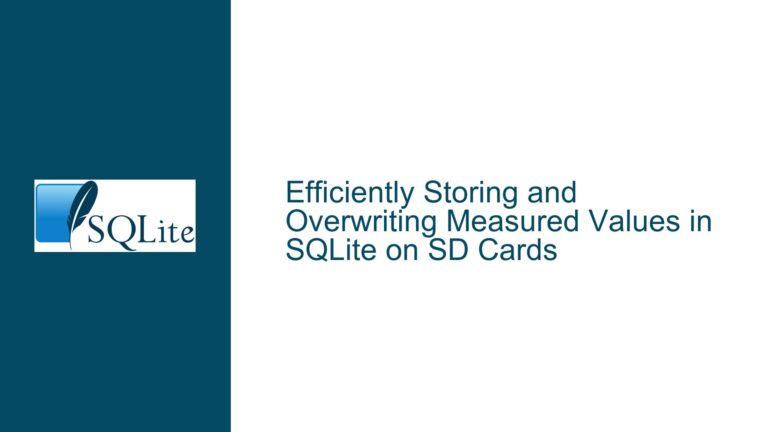Efficiently Modeling Hierarchical Tags and Implied Relationships in SQLite
Issue Overview: Modeling Hierarchical Tags with Implied Relationships in SQLite
The core issue revolves around designing an efficient SQLite schema to model hierarchical tags, where one tag can imply another, and querying these relationships in a performant manner. The goal is to create a system where entities (e.g., objects, items, or records) can be tagged, and these tags can have hierarchical or implied relationships. For example, a tag like lizard might imply the tag reptile, and reptile might further imply animal. When querying for entities tagged with lizard, the system should also return entities tagged with reptile and animal due to the implied relationships.
The initial schema proposed includes three main tables: entity, tag, and entity_tags. The entity table stores the entities, the tag table stores the tags, and the entity_tags table creates a many-to-many relationship between entities and tags. To model the implied relationships between tags, a fourth table, tag_implies, is introduced. This table stores pairs of tags where the subject_tag implies the object_tag.
The primary challenges are:
- Querying Implied Tags Efficiently: The system must efficiently query all tags (both direct and implied) for a given entity. This requires traversing the implied tag relationships recursively.
- Preventing Cyclic Relationships: The system must ensure that the implied tag relationships do not form cycles, which could lead to infinite recursion during queries.
- Optimizing Entity Lookups by Tags: The system must efficiently find entities that match a set of tags, considering both direct and implied relationships.
Possible Causes: Challenges in Hierarchical Tag Modeling and Querying
The challenges in modeling and querying hierarchical tags in SQLite stem from several factors:
Recursive Relationships: The implied tag relationships are inherently recursive. A tag can imply another tag, which in turn can imply yet another tag, and so on. This recursion makes it difficult to write straightforward SQL queries, as SQLite does not natively support recursive queries without the use of Common Table Expressions (CTEs).
Performance Bottlenecks: Recursive CTEs, while powerful, can be computationally expensive, especially when dealing with large datasets or deeply nested tag hierarchies. The system must carefully optimize these queries to avoid performance bottlenecks.
Data Integrity: Ensuring that the implied tag relationships do not form cycles is crucial. A cycle in the tag hierarchy could lead to infinite recursion during queries, causing the database to hang or crash. Enforcing this constraint at the database level is non-trivial and may require application-level checks.
Complexity in Querying: Querying for entities that match a set of tags, considering both direct and implied relationships, adds another layer of complexity. The system must efficiently resolve the implied tags for each tag in the set and then match these against the entities’ tags.
Troubleshooting Steps, Solutions & Fixes: Implementing and Optimizing Hierarchical Tags in SQLite
1. Schema Design and Data Integrity
The first step in addressing the issue is to refine the schema design to ensure data integrity and optimize query performance. The following schema modifications are recommended:
CREATE TABLE entities (
id INTEGER PRIMARY KEY NOT NULL,
name TEXT NOT NULL COLLATE NOCASE UNIQUE
);
CREATE TABLE tags (
id INTEGER PRIMARY KEY NOT NULL,
name TEXT NOT NULL COLLATE NOCASE UNIQUE
);
CREATE TABLE entity_tags (
entity INTEGER NOT NULL REFERENCES entities(id),
tag INTEGER NOT NULL REFERENCES tags(id),
PRIMARY KEY (entity, tag)
) WITHOUT ROWID;
CREATE TABLE tag_implies (
subject INTEGER NOT NULL REFERENCES tags(id),
object INTEGER NOT NULL REFERENCES tags(id),
PRIMARY KEY (subject, object)
) WITHOUT ROWID;
Key Improvements:
- UNIQUE Constraints: The
namecolumns in theentitiesandtagstables are marked asUNIQUEto prevent duplicate entries. This ensures that each entity and tag name is unique, avoiding ambiguity. - COLLATE NOCASE: The
COLLATE NOCASEoption ensures that tag and entity names are case-insensitive, preventing issues where "Red" and "red" are treated as different tags. - WITHOUT ROWID: The
entity_tagsandtag_impliestables are created with theWITHOUT ROWIDoption. This optimizes storage and query performance by eliminating the need for a separate rowid column, as the primary key columns are sufficient for indexing.
2. Querying Implied Tags Efficiently
To query all tags (both direct and implied) for a given entity, a recursive CTE can be used. The following query demonstrates how to achieve this:
WITH RECURSIVE full_tags(entity, tag, isImplied) AS (
SELECT entity, tag, FALSE
FROM entity_tags
WHERE entity = @entity_id
UNION ALL
SELECT full_tags.entity, tag_implies.object, TRUE
FROM tag_implies
JOIN full_tags ON full_tags.tag = tag_implies.subject
)
SELECT entities.name AS entity_name, tags.name AS tag_name, isImplied
FROM full_tags
JOIN entities ON entities.id = full_tags.entity
JOIN tags ON tags.id = full_tags.tag;
Explanation:
- Base Case: The base case of the CTE selects all direct tags for the given entity.
- Recursive Case: The recursive part of the CTE joins the
tag_impliestable with thefull_tagsCTE to find all implied tags. This process continues until no more implied tags are found. - Final Selection: The final
SELECTstatement joins thefull_tagsCTE with theentitiesandtagstables to retrieve the entity name, tag name, and whether the tag is implied.
3. Preventing Cyclic Relationships
To prevent cycles in the implied tag relationships, a check must be performed whenever a new implied relationship is added. This can be done using a recursive CTE to detect cycles:
WITH RECURSIVE tag_cycle_check(subject, object, path) AS (
SELECT subject, object, subject || ',' || object
FROM tag_implies
WHERE subject = @new_subject AND object = @new_object
UNION ALL
SELECT ti.subject, ti.object, tcc.path || ',' || ti.object
FROM tag_implies ti
JOIN tag_cycle_check tcc ON ti.subject = tcc.object
WHERE tcc.path NOT LIKE '%' || ti.object || '%'
)
SELECT CASE WHEN COUNT(*) > 0 THEN 'Cycle Detected' ELSE 'No Cycle' END AS cycle_check
FROM tag_cycle_check
WHERE subject = object;
Explanation:
- Base Case: The base case selects the new implied relationship being added.
- Recursive Case: The recursive part of the CTE traverses the implied tag relationships, building a path of tag IDs. If a tag ID appears more than once in the path, a cycle is detected.
- Cycle Detection: The final
SELECTstatement checks if any rows are returned where thesubjectandobjectare the same, indicating a cycle.
This query should be run before inserting a new implied relationship. If a cycle is detected, the insertion should be aborted.
4. Optimizing Entity Lookups by Tags
To efficiently find entities that match a set of tags, considering both direct and implied relationships, the following approach can be used:
WITH RECURSIVE tag_descendants(tag, descendant) AS (
SELECT id, id
FROM tags
WHERE id IN @tag_set
UNION ALL
SELECT td.tag, ti.object
FROM tag_implies ti
JOIN tag_descendants td ON ti.subject = td.descendant
)
SELECT e.id, e.name
FROM entities e
JOIN entity_tags et ON e.id = et.entity
JOIN tag_descendants td ON et.tag = td.descendant
WHERE td.tag IN @tag_set
GROUP BY e.id
HAVING COUNT(DISTINCT td.tag) = @num_tags;
Explanation:
- Base Case: The base case of the CTE selects all tags in the input set.
- Recursive Case: The recursive part of the CTE finds all descendants of the tags in the input set by traversing the
tag_impliestable. - Entity Lookup: The final
SELECTstatement joins thetag_descendantsCTE with theentity_tagstable to find entities that have tags matching the descendants of the input tags. TheHAVINGclause ensures that the entity matches all tags in the input set.
5. Further Optimization Considerations
Indexing: Ensure that appropriate indexes are created on the
entity_tagsandtag_impliestables to speed up joins and lookups. For example:CREATE INDEX idx_entity_tags_tag ON entity_tags(tag); CREATE INDEX idx_tag_implies_subject ON tag_implies(subject); CREATE INDEX idx_tag_implies_object ON tag_implies(object);Query Caching: If the tag hierarchy is relatively static, consider caching the results of expensive queries (e.g., the full list of implied tags for each entity) to avoid recomputing them frequently.
Application-Level Checks: While SQLite provides powerful tools for recursive queries, some checks (e.g., cycle detection) may be more efficiently implemented at the application level, especially if the tag hierarchy is large or frequently updated.
By carefully designing the schema, optimizing queries, and implementing checks to prevent cycles, it is possible to efficiently model and query hierarchical tags with implied relationships in SQLite.






